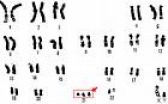What Is Down Syndrome?
Down syndrome, or trisomy-21, is a genetic condition in which an individual has 47 chromosomes, instead of the usual 46.
In 95% of all cases of Down syndrome (DS), there is a triplication (trisomy) of the 21st chromosome. This is also called nondisjunction.
DS is the single most cause of all birth defects in babies.
Individuals with DS have a wide range of abilites and symptoms. Medical issues include heart defects such as atrial septal defect and ventricular septal defect. There could also be thyroid issues, and leukemia.
Individuals with DS are living longer than ever before - in 1929, the life expectancy was just 9 short years. Now, in 2009, the life expectancy is well into the 60s. The oldest living person with Down syndrome is 80 years old, and lives in Waseca, MN. He will be in the 2009 edition of the Guiness Book of World Records.
Treatment
There is currently no cure or prevention for DS, but there are some things that can be done to ensure your child has the best possible life.
In most states, there is a program for infants, called Early Intervention (name varies state-to-state). What is included in that program is occupational therapy (fine motor skills), physical therapy, speech therapy and usually an Early Childhood Special Education Teacher. This program is usually through the school district. Early Intervention (EI) should begin at birth or shortly after, and will continue until the child turns 3.
At age 3, the child will transition into the school system, into Head Start of Preschool. They will be given an IEP (Individualized Education Plan) and will receive services according to that plan.
Children with DS can go to school just like every other child, and be included into the classroom and curriculum. Some may need a little more assistance than others.


